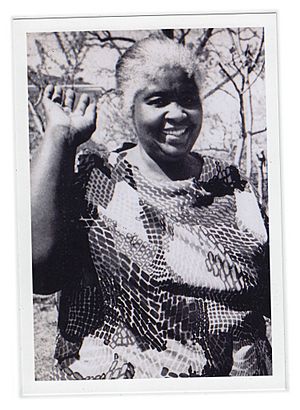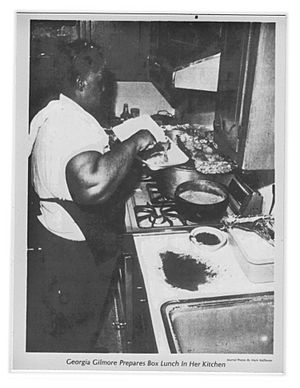Georgia Gilmore facts for kids
Quick facts for kids
Georgia Teresa Gilmore
|
|
|---|---|
 |
|
| Born | February 5, 1920 |
| Died | March 7, 1990 |
| Nationality | American |
| Known for | Montgomery bus boycott and fundraising through The Club from Nowhere |
| Children | 6 |
Georgia Teresa Gilmore (born February 5, 1920 – died March 7, 1990) was an African American woman from Montgomery, Alabama. She played a key role in the Montgomery bus boycott. She helped by creating a group called the Club from Nowhere. This group sold food to raise money for the boycott. Her local efforts helped keep the 382-day boycott going strong. She also inspired other groups to start similar fundraising activities.
Contents
Early Life and Activism
Georgia Gilmore was born in Montgomery County, Alabama on February 5, 1920. She was one of five children. As a child, she went to a church school run by nuns. Throughout her life, Gilmore worked as a cook and a domestic worker. She also worked on the railroad. She lived in Montgomery with her six children. In the 1950s, she also helped care for her mother and younger sister.
Gilmore was known as a kind and motherly woman. She was also an amazing cook. She had a bold personality and often spoke out against unfair treatment. She was a member of the local NAACP in Montgomery. There, she worked with Rosa Parks and others to fight against discrimination. Before the bus boycott, Gilmore decided to stop riding city buses. This was after she and her mother faced discrimination on a bus. She was not afraid to stand up for herself and her family.
Supporting the Bus Boycott
On December 1, 1955, Rosa Parks was arrested for refusing to give up her seat on a bus. After this, the Women's Political Council called for a boycott of the bus system. The boycott started on December 5. A group of community leaders and ministers formed the Montgomery Improvement Association (MIA). This group helped lead the boycott.
Gilmore had already stopped using the buses. She heard about Rosa Parks' arrest and the first MIA meeting. This meeting was held at Holt Street Baptist Church on the evening the boycott began. Gilmore met Martin Luther King Jr., who was the president of the MIA. She joined the organization that very night.
Gilmore and her friends started a fundraising group. They called it the Club from Nowhere. This group helped support the boycott and the MIA. Georgia Gilmore also spoke out about the unfair treatment she faced on city buses. Her involvement led to her losing her job at the National Lunch Company. But this did not stop Gilmore. She later said that "this new generation had decided that they just had taken as much as they could."
After she lost her job, Martin Luther King Jr. and other MIA leaders helped Gilmore. They helped her set up her own restaurant in her home. This allowed her to earn a living. Even though it wasn't a licensed restaurant, Gilmore's home became a place where Dr. King and other MIA members could eat, meet, and plan their next steps.
The Club from Nowhere
Gilmore started the Club from Nowhere at the first mass meeting on December 5. She and her friends began selling fried chicken sandwiches. They sold them in the parking lot and on the church steps. The women continued selling sandwiches at these meetings. Soon, they officially formed their fundraising group, the Club from Nowhere.
Their sales were very successful. This led Gilmore and her friends to make whole meals. They sold chicken dinners, cakes, and pies to people supporting the boycott. The women sold food across Montgomery. They even had white customers who bought food from them, sometimes without knowing where the money was going.
The money raised from these sales went to the Montgomery Improvement Association. It also helped pay for the carpool system. This system was very important for keeping the boycott going. Gilmore named her group "the Club from Nowhere" to keep its members and donors secret. Some of their donors were white, and keeping them anonymous helped avoid problems. Gilmore made herself the only officer of the club. Members gave her all the money they made. She then donated it to the MIA at weekly meetings.
The club soon raised hundreds of dollars each week. They sold their meals from beauty parlors, laundromats, and other places. Both boycotters and supporters of the movement visited these spots. Gilmore's group would present their weekly earnings at meetings. The audience would cheer loudly. Gilmore hoped that her group's success would encourage other "ordinary folks" to do the same. This organization and others like it helped keep the boycott alive. They provided money and strong community support.
Impact of the Club
Gilmore and the Club from Nowhere showed how much African American women helped the bus boycott. They gave money and were deeply committed to the cause. The club also inspired another group called the Friendly Club. This group was started by Inez Ricks and also raised money for the MIA.
Gilmore's son, Mark, later said that she turned her everyday cooking into something much bigger. In an interview from 1986, Gilmore said that African American women were a main reason the boycott succeeded. She explained, "you see they were maids, cooks. And they was the one that really and truly kept the bus running."
Fighting for Equal Parks
Gilmore v. City of Montgomery (1959)
In 1957, Georgia Gilmore's son, Mark, was arrested. Two white police officers beat him. This happened while he was taking a shortcut through Oak Park. At that time, Oak Park was only for white people. African Americans were not allowed to use public parks and recreation places by local law.
Gilmore was the main person who brought a lawsuit called Gilmore v. City of Montgomery (1959). This case challenged the ban on African Americans using public parks. Gilmore won the case. The court ruled that the ban was against the Fourteenth Amendment of the U.S. Constitution. This amendment ensures equal protection under the law. The court said Montgomery's policy of separate parks was illegal. The city first responded by closing the public parks instead of letting everyone use them.
Gilmore v. City of Montgomery (1974)
In 1971, the case was reopened and went to the Supreme Court. The City of Montgomery had reopened its public parks and recreation places in the early 1970s. However, the city allowed private schools and the YMCA, which were still segregated, to use these public parks only for white people. Gilmore won this second case in 1974. The court ruled that taxpayer money was being used to fund these public spaces for white-only private school sports programs. This was unfair and illegal.
Later Life and Legacy
In May 1961, the Freedom Riders arrived at the Greyhound Station in Montgomery, Alabama. A large group of people attacked the young protestors. Many were injured. Georgia Gilmore bravely gave shelter to several injured protestors in her home. She kept them safe until they could leave.
Gilmore also appeared in the Eyes on the Prize documentary. This famous TV series tells the story of the Civil Rights Movement. Her well-known recipes can still be found in cookbooks today.
Georgia Gilmore passed away on March 7, 1990. She was making food for the twenty-fifth anniversary of the Selma to Montgomery March at the time.
Images for kids





